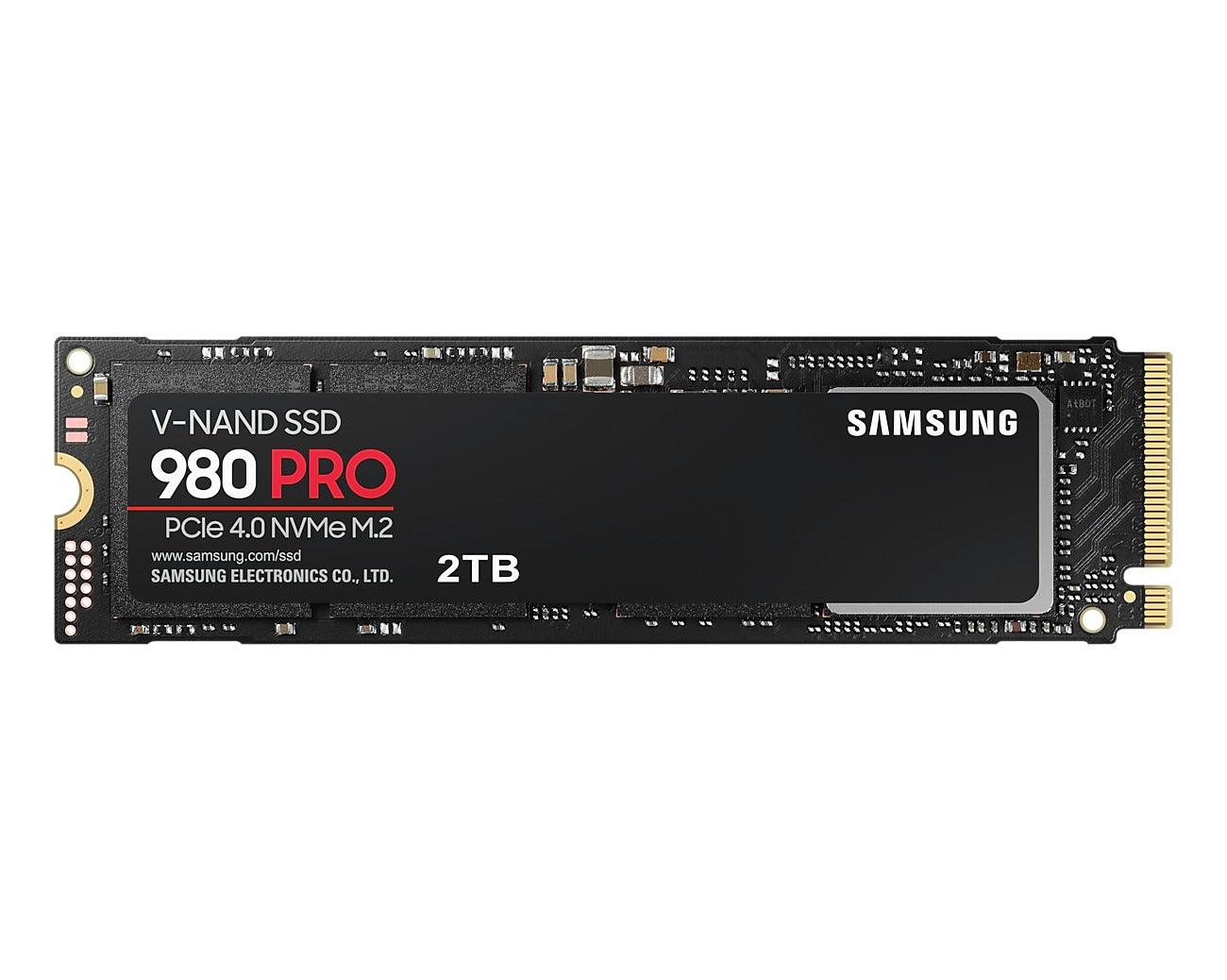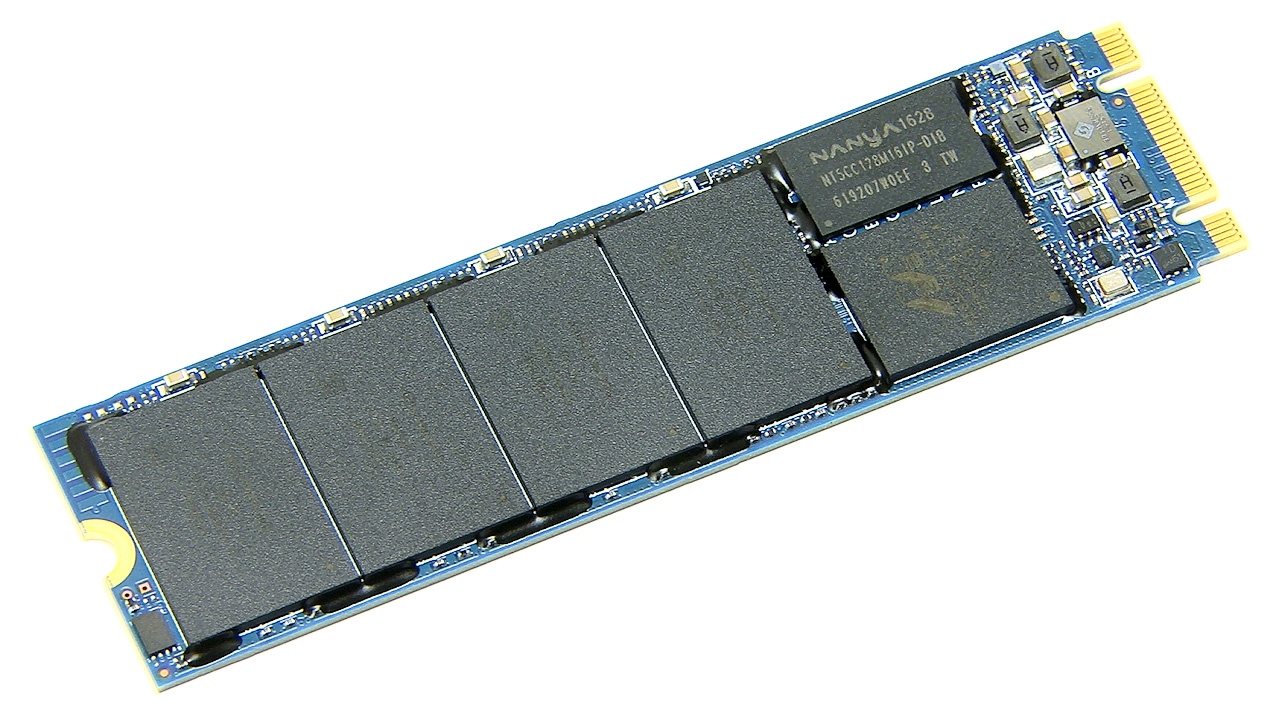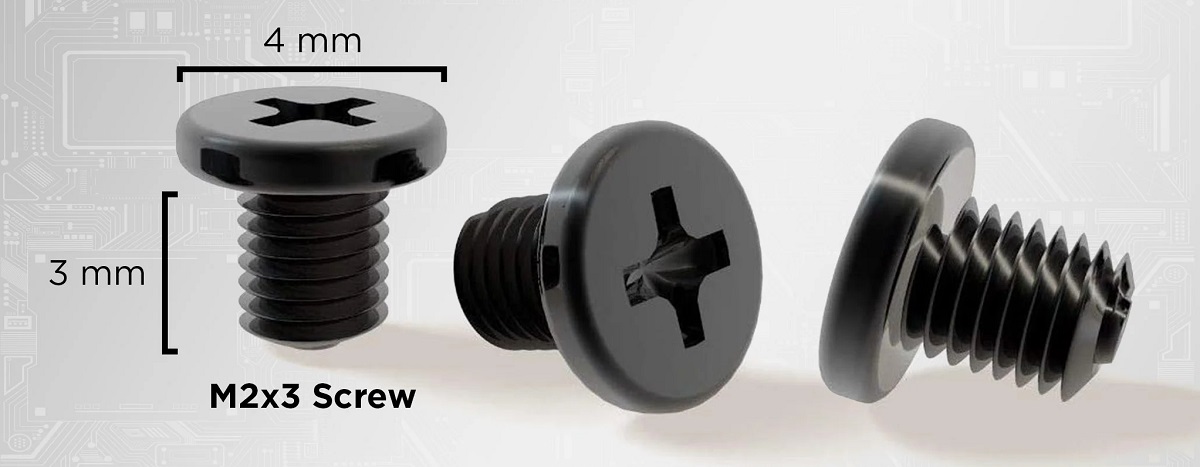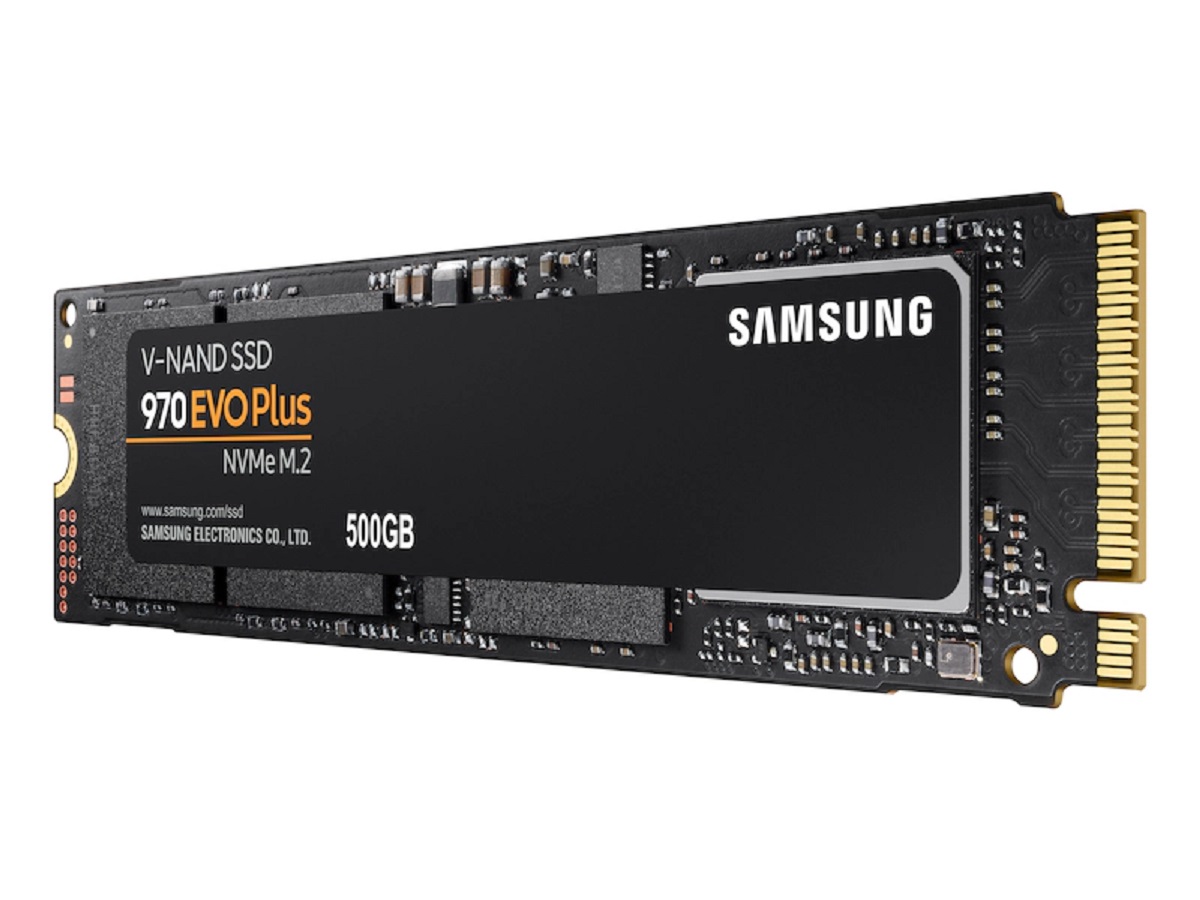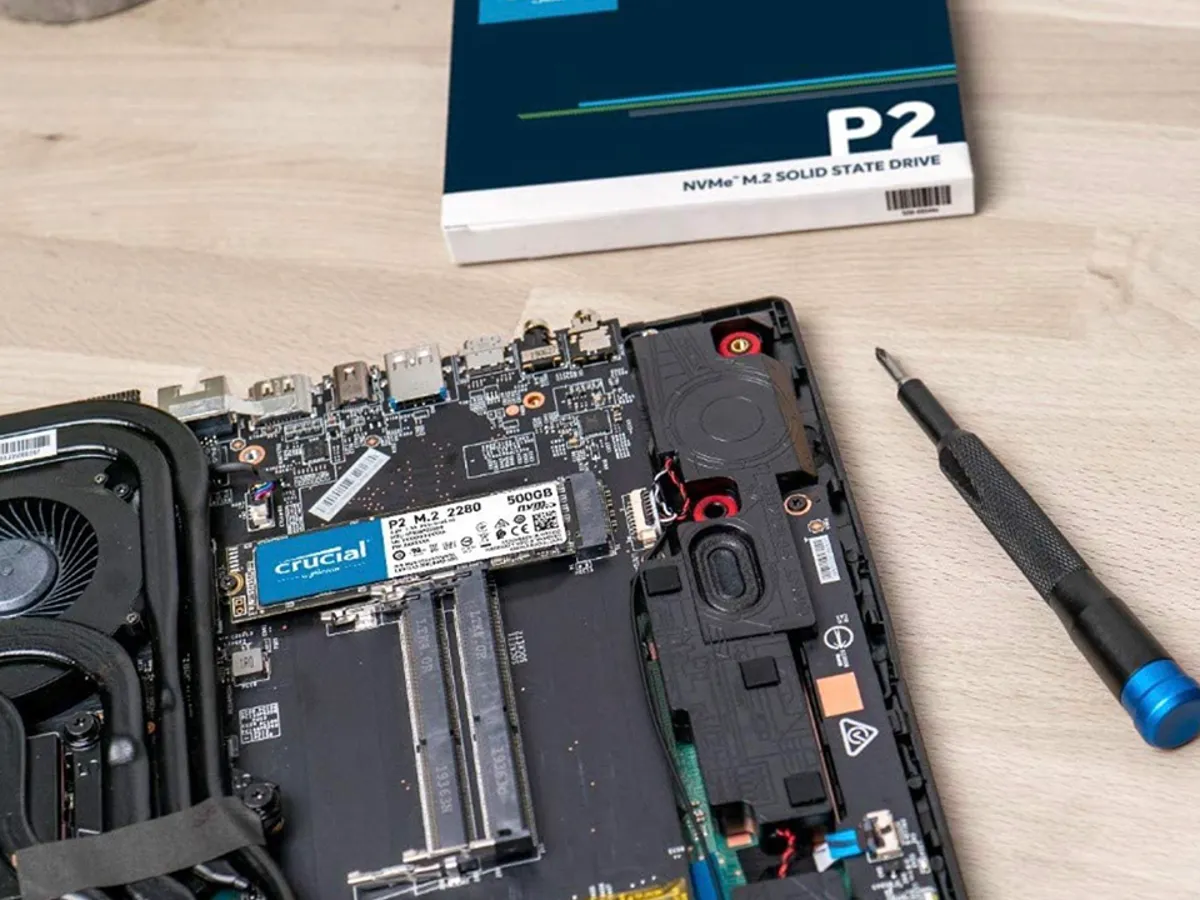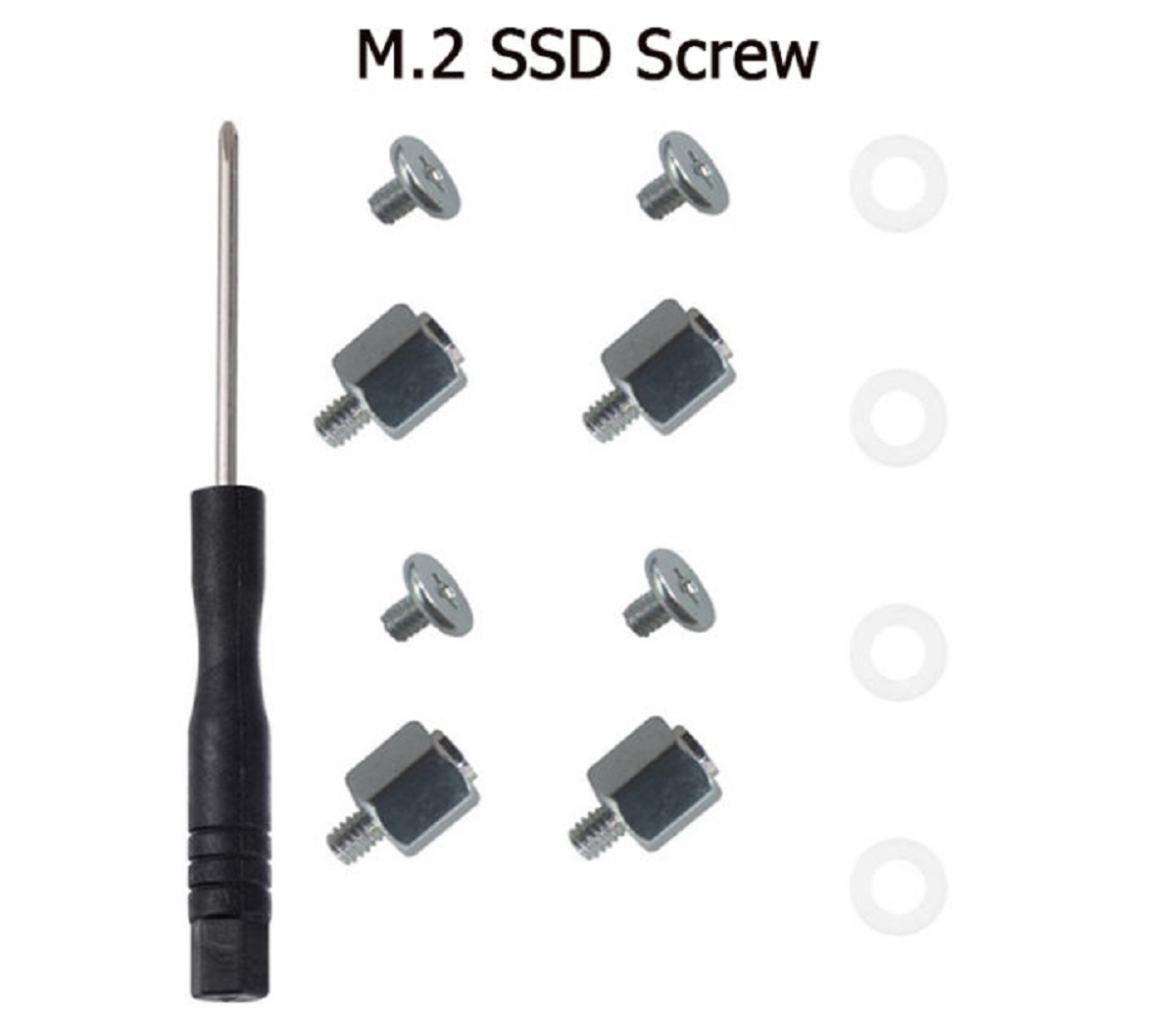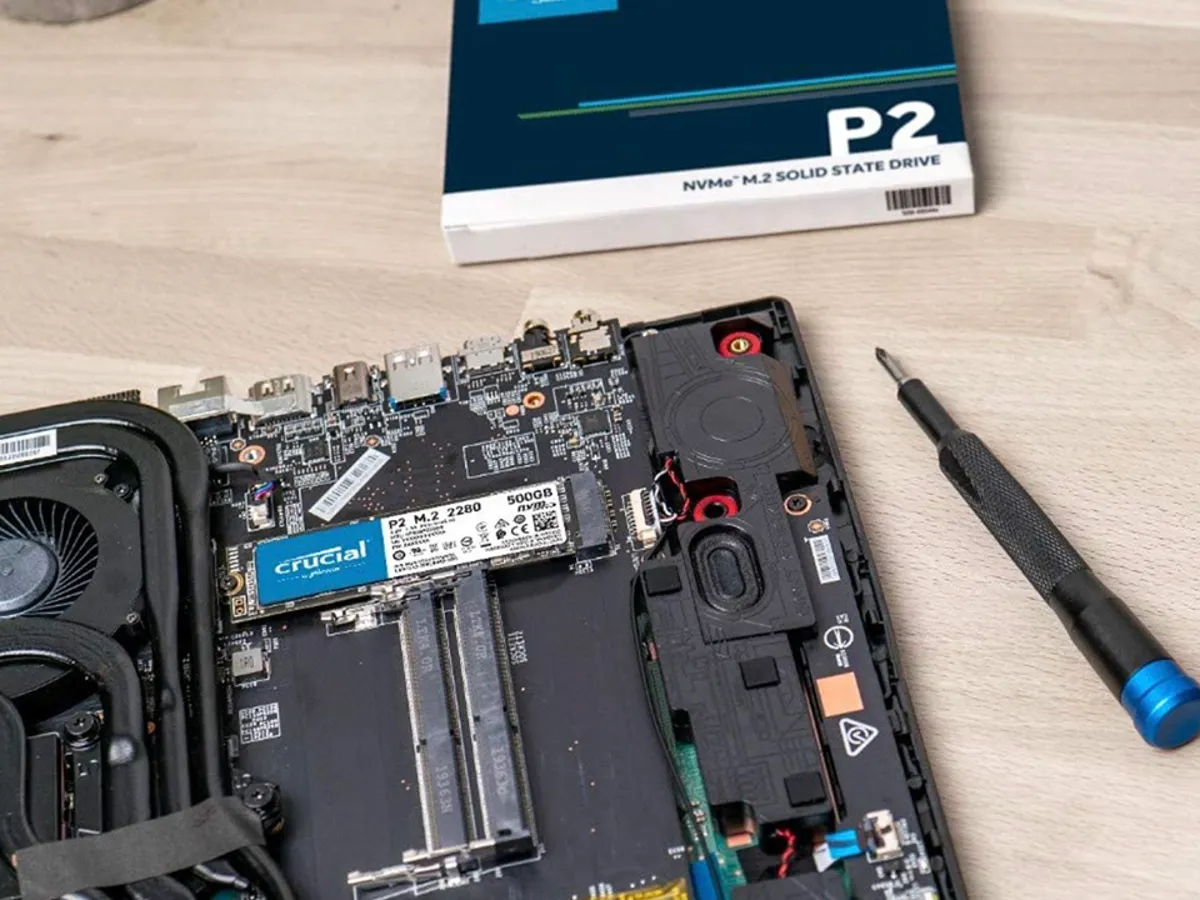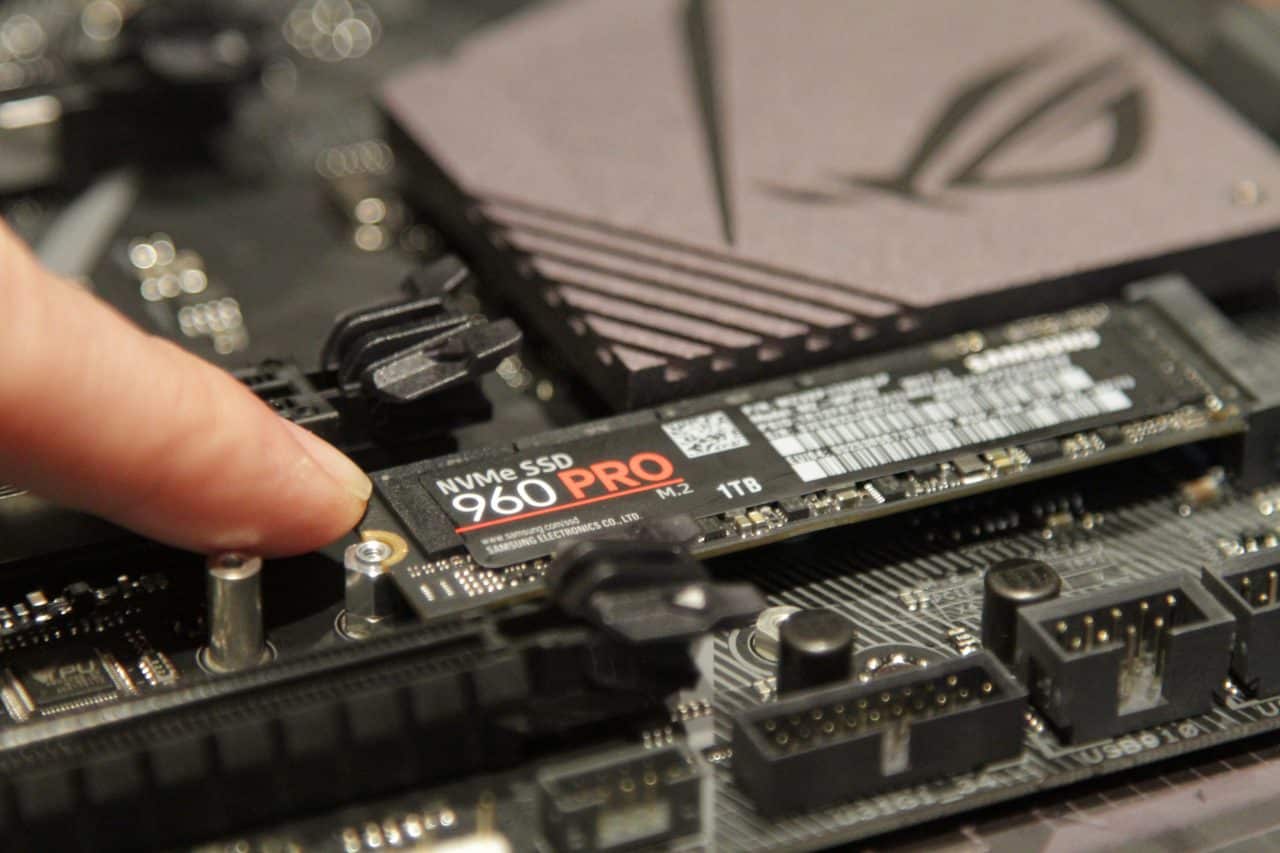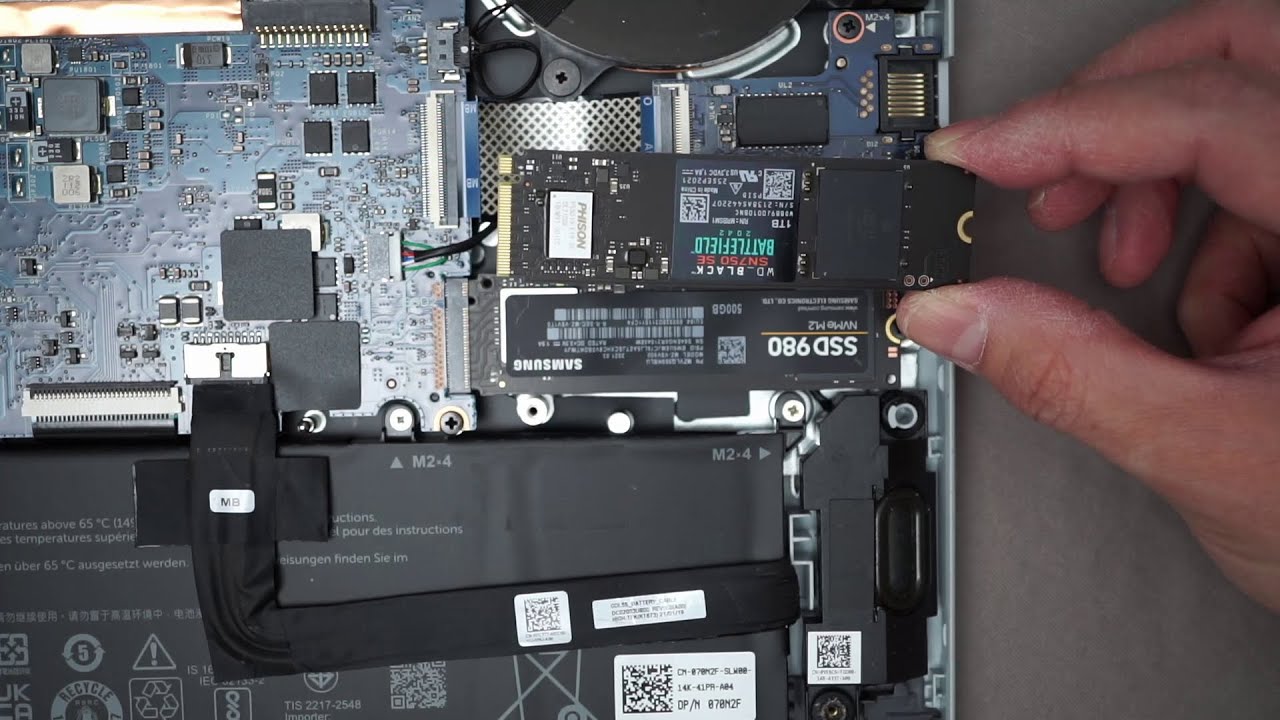Introduction
An M.2 SSD, or M.2 solid-state drive, is a compact and high-performance storage device that has gained popularity in recent years. With its small form factor and impressive speed, the M.2 SSD has revolutionized the world of storage, providing faster and more efficient data transfer for various devices.
Traditionally, hard disk drives (HDDs) and standard solid-state drives (SSDs) have been the go-to options for storage solutions. However, with the introduction of the M.2 SSD, users can now experience even greater performance and versatility.
The M.2 SSD is designed to fit directly into the motherboard, eliminating the need for cables and connections. Its compact size makes it ideal for laptops, ultrabooks, and small-form-factor PCs, where space is often limited.
Not only does the M.2 SSD offer a smaller physical footprint, but it also boasts impressive speed and performance capabilities. It utilizes the NVMe (Non-Volatile Memory Express) protocol, which enables faster data transfer rates than traditional SSDs.
In this article, we will explore the world of M.2 SSDs, delve into their advantages over traditional storage options, discuss the different types and form factors available, and provide insights into their compatibility and capacity considerations.
Whether you’re a tech enthusiast searching for an upgrade or a casual user looking to improve your device’s performance, understanding the benefits and features of an M.2 SSD can help you make an informed decision.
What is an M.2 SSD?
An M.2 SSD is a solid-state drive that utilizes the M.2 form factor and interface for storage purposes. It is a compact and slim storage solution that has gained popularity due to its high performance and versatility.
Unlike traditional storage options such as hard disk drives (HDDs) or even 2.5-inch solid-state drives (SSDs), which connect via cables and connectors, the M.2 SSD directly attaches to the motherboard. This eliminates the need for additional cables and reduces clutter inside the system.
One of the key advantages of an M.2 SSD is its small form factor. It is significantly smaller and thinner than its counterparts, allowing it to fit seamlessly into modern devices like laptops, ultrabooks, and compact desktops. This makes it an excellent choice for users who prioritize portability or have space constraints.
Another distinguishing feature of M.2 SSDs is their impressive speed and performance. Most M.2 SSDs utilize the NVMe (Non-Volatile Memory Express) protocol, which allows for faster data transfer rates compared to traditional SATA-based SSDs. NVMe takes advantage of the PCIe (Peripheral Component Interconnect Express) interface, enabling high-speed communication between the SSD and the motherboard.
Furthermore, M.2 SSDs are available in various capacities, ranging from 128GB to several terabytes, allowing users to choose the capacity that best suits their storage requirements.
In addition to its compact size and high performance, M.2 SSDs also consume less power than traditional storage options. This not only extends battery life in portable devices but also reduces the overall energy consumption of the system.
Overall, M.2 SSDs offer a compelling storage solution with their small form factor, impressive performance, and energy efficiency. Whether you are a gamer, content creator, or professional, the M.2 SSD provides a high-speed and reliable storage option to enhance your computing experience.
Advantages of M.2 SSDs
M.2 SSDs bring several advantages over traditional storage options, making them a popular choice among users looking for high-performance and reliable storage solutions. Here are some key advantages of M.2 SSDs:
- Compact Size: One of the primary advantages of M.2 SSDs is their small form factor. They are significantly smaller and thinner than traditional hard drives or even 2.5-inch SSDs. This compact size allows M.2 SSDs to fit into slim and portable devices without sacrificing storage capacity.
- High Performance: M.2 SSDs utilize the NVMe protocol, which enables faster data transfer rates compared to SATA-based SSDs. This translates into shorter boot times, quicker application loading, and improved system responsiveness. The PCIe interface used by M.2 SSDs provides a higher bandwidth, allowing for better overall performance.
- Improved Energy Efficiency: M.2 SSDs consume less power compared to traditional storage options. With lower power consumption, these SSDs help extend battery life in laptops and other portable devices. Additionally, reduced power usage contributes to a more energy-efficient system.
- No Cable Clutter: Unlike traditional storage drives that require cables and connectors, M.2 SSDs are directly connected to the motherboard. This eliminates cable clutter inside the computer chassis and simplifies the installation process.
- Easy Installation: Installing an M.2 SSD is a straightforward process. Most modern motherboards have dedicated M.2 slots, allowing users to install the SSD without additional adapters or cables. This makes it convenient for users to upgrade their storage or add more storage capacity without much hassle.
- Multiple Form Factors: M.2 SSDs are available in various form factors, such as 2280, 2260, and 2242, among others. These form factors differ in length and width, providing flexibility for compatibility with different devices and motherboard configurations.
With their compact size, high performance, energy efficiency, and easy installation, M.2 SSDs are an excellent choice for users seeking fast and reliable storage solutions. Whether you are a gamer, professional, or casual user, the advantages of M.2 SSDs can greatly enhance your computing experience.
Different Types of M.2 SSDs
M.2 SSDs come in different types, each catering to specific storage needs and performance requirements. Here are the main types of M.2 SSDs:
- SATA M.2 SSD: SATA M.2 SSDs are the most common type and are compatible with most motherboards. They use the SATA III interface, which offers good performance but is limited by the slower data transfer speeds compared to NVMe-based SSDs. SATA M.2 SSDs are suitable for general computing tasks and offer an affordable storage option.
- NVMe M.2 SSD: NVMe M.2 SSDs utilize the NVMe (Non-Volatile Memory Express) protocol and the PCIe (Peripheral Component Interconnect Express) interface for significantly faster data transfer rates. These SSDs deliver superior performance, making them ideal for demanding tasks like gaming, 3D rendering, and video editing. NVMe M.2 SSDs are often more expensive than SATA-based ones but provide a significant boost in speed and overall system performance.
- TLC, MLC, and SLC: These are different types of NAND flash memory used in M.2 SSDs. TLC (Triple-Level Cell) SSDs offer higher storage capacity and lower cost but have slightly lower endurance. MLC (Multi-Level Cell) SSDs offer a balance between capacity and endurance, making them suitable for professional and power users. SLC (Single-Level Cell) SSDs have the highest endurance and are often used in enterprise-grade SSDs.
- Optane M.2 SSD: Optane M.2 SSDs, developed by Intel, use 3D XPoint memory technology. These SSDs offer extremely fast performance, low latency, and high endurance. Optane SSDs are ideal for users who require top-tier performance, such as professionals working with large datasets and high-speed data processing.
When choosing an M.2 SSD, consider your specific storage requirements, budget, and desired level of performance. If you need faster data transfer speeds and higher performance, NVMe M.2 SSDs are the way to go. However, if you’re on a tight budget or require a more cost-effective solution for general computing tasks, SATA M.2 SSDs can still provide adequate performance.
It’s also important to consider the endurance and longevity of the SSD, especially if you’re a heavy user or rely on your storage for critical tasks. MLC or SLC SSDs generally offer better endurance compared to TLC SSDs.
Ultimately, the choice of an M.2 SSD will depend on your specific needs and budget. It’s always recommended to research and compare different M.2 SSD options to find the one that best suits your requirements.
M.2 SSD Form Factors
M.2 SSDs are available in various form factors, which determine their physical dimensions and compatibility. Here are the main M.2 SSD form factors:
- 2280: The 2280 form factor is the most common size for M.2 SSDs. The number represents the dimensions, with the first two digits referring to the width (22mm) and the last two digits representing the length (80mm). This form factor provides a good balance between storage capacity and compatibility.
- 2260: The 2260 form factor is similar to the 2280, but with a shorter length (60mm). This makes it suitable for smaller devices that have limited space for storage, such as ultrabooks and compact desktops.
- 2242: The 2242 form factor is smaller than the 2280 and 2260, with a length of 42mm. This compact size is ideal for devices like thin and light laptops or embedded systems that require storage in a tight space.
- 2230: The 2230 form factor is the smallest among the commonly used M.2 SSD sizes, with a length of 30mm. This form factor is often used in specialized applications, such as Wi-Fi and Bluetooth modules.
When choosing an M.2 SSD, it’s important to check the available M.2 slots on your motherboard or device to ensure compatibility. Motherboards typically support multiple M.2 form factors, but it’s essential to choose an SSD with a form factor that fits the available slot.
It’s worth noting that some M.2 slots might support multiple form factors. For example, a slot labeled “M-key” or “M+B-key” can accommodate both SATA and NVMe M.2 SSDs, while a “B-key” slot typically supports SATA-only SSDs.
Before purchasing an M.2 SSD, consult your device’s documentation or motherboard specifications to determine the supported form factors and key types. This will ensure that the M.2 SSD you choose is compatible with your specific device.
By understanding the different M.2 SSD form factors, you can select the appropriate size to fit your device’s requirements and enjoy the benefits of fast and reliable storage.
M.2 SSD Interface
The M.2 SSD interface refers to the connector and communication protocol used by M.2 SSDs to connect to the motherboard. The interface plays a crucial role in determining the speed and compatibility of the M.2 SSD. There are generally two main types of M.2 SSD interfaces:
- SATA: SATA (Serial ATA) is the older and more common interface used by M.2 SSDs. It provides a maximum data transfer speed of around 600MB/s, which is significantly faster than traditional hard drives but slower compared to the NVMe interface. SATA M.2 SSDs are compatible with most motherboards that have M.2 slots. They are a cost-effective option for users who want to upgrade from traditional hard drives or those who need a moderate increase in speed.
- NVMe: NVMe (Non-Volatile Memory Express) is a newer and faster interface specifically designed for solid-state drives. Unlike SATA, which can be limited by its interface speed, the NVMe interface takes advantage of the PCIe (Peripheral Component Interconnect Express) technology to provide significantly higher data transfer rates. NVMe M.2 SSDs can deliver sequential read and write speeds of multiple gigabytes per second, offering exceptional performance for demanding tasks like gaming, video editing, and data-intensive workloads.
When choosing an M.2 SSD, it’s crucial to determine whether your motherboard supports SATA, NVMe, or both interfaces. Most modern motherboards have M.2 slots that support both SATA and NVMe SSDs, but it’s always advisable to double-check the specifications.
If your motherboard supports NVMe, opting for an NVMe M.2 SSD can provide a significant boost in storage performance. However, if your motherboard only supports SATA, a SATA M.2 SSD can still provide a noticeable improvement in speed and responsiveness compared to traditional hard drives.
It’s also important to note that while NVMe M.2 SSDs offer blazing-fast speeds, their performance is dependent on the capabilities of your motherboard’s PCIe slots. Older motherboards or budget-oriented models might have slower PCIe lanes, which can limit the maximum speed achievable by the NVMe SSD.
Ultimately, understanding the M.2 SSD interface options allows you to choose the right type of M.2 SSD that matches your system’s compatibility and performance needs. Whether you go for SATA or NVMe, upgrading to an M.2 SSD will undoubtedly bring a significant improvement in your storage speed and overall computing experience.
M.2 SSD Speeds and Performance
M.2 SSDs are known for their impressive speed and performance, offering significantly faster data transfer rates compared to traditional storage options. The performance of an M.2 SSD is influenced by several factors:
- Interface: The interface of the M.2 SSD plays a crucial role in its speed and performance. SATA-based M.2 SSDs typically offer read and write speeds of up to 600MB/s, while NVMe-based M.2 SSDs can deliver sequential read and write speeds of multiple gigabytes per second. The NVMe interface, utilizing the PCIe technology, provides significantly higher bandwidth for faster data transfer.
- Form Factor: The form factor of the M.2 SSD does not directly affect its speed and performance. However, it determines the physical dimensions and compatibility with different devices and motherboards.
- Memory Technology: M.2 SSDs utilize different types of NAND flash memory, such as TLC (Triple-Level Cell), MLC (Multi-Level Cell), and SLC (Single-Level Cell). SLC-based SSDs generally offer higher endurance and faster performance, while TLC-based SSDs provide higher storage capacity but may have slightly slower speeds.
- Sequencing: SSDs exhibit faster sequential read and write speeds compared to random read and write speeds. Sequential access refers to continuous data transfer, while random access involves accessing data stored in various locations. Sequential speeds are typically higher in M.2 SSDs and are beneficial for tasks like large file transfers and media streaming.
- Controller and Cache: The controller and cache of an M.2 SSD also impact its performance. Quality controllers and larger cache sizes can enhance data handling and improve overall responsiveness.
It’s important to note that the actual performance of an M.2 SSD may vary depending on the specific model, brand, and other system configurations. Manufacturers usually provide specifications for their SSDs, which include read and write speeds under optimal conditions.
When choosing an M.2 SSD, consider your usage requirements and prioritize the speed and performance aspects accordingly. If you engage in demanding tasks like gaming, video editing, or professional workloads, opting for an NVMe M.2 SSD with higher sequential speeds can provide a noticeable performance boost.
However, for general computing tasks and everyday use, even a SATA-based M.2 SSD can offer significant improvements in speed and responsiveness compared to traditional hard drives.
Overall, M.2 SSDs excel in providing fast and efficient storage for various applications. Whether you’re a professional or a casual user, the speed and performance of an M.2 SSD can greatly enhance your computing experience and boost overall productivity.
M.2 SSD vs Traditional SSD
M.2 SSDs and traditional SSDs offer similar benefits over traditional hard disk drives (HDDs), such as faster data access, improved durability, and quieter operation. However, there are several key differences between M.2 SSDs and traditional SSDs:
- Form Factor: One of the primary differences is the form factor. Traditional SSDs usually come in a 2.5-inch size, similar to laptop HDDs. On the other hand, M.2 SSDs have a smaller and more compact form factor, making them ideal for thin and light devices or systems with limited space.
- Interface: Another difference lies in the interface. Traditional SSDs typically use the SATA III interface, providing maximum data transfer speeds of around 600MB/s. In contrast, M.2 SSDs can use the SATA III interface or the NVMe (Non-Volatile Memory Express) interface, which offers significantly faster data transfer rates. NVMe M.2 SSDs can deliver sequential read and write speeds of multiple gigabytes per second, providing a substantial performance boost.
- Installation: Installing an M.2 SSD is generally easier than installing a traditional SSD. M.2 SSDs attach directly to the motherboard without requiring cables or connectors, simplifying the installation process. Traditional SSDs, on the other hand, require connections to the motherboard using SATA cables.
- Compatibility: Traditional SSDs with the 2.5-inch form factor and SATA interface are widely compatible with desktops, laptops, and external enclosures. M.2 SSDs are compatible with devices that have M.2 slots on their motherboards, but compatibility may vary depending on the specific form factor and interface.
- Speed and Performance: While traditional SSDs offer faster data access times compared to HDDs, M.2 SSDs, especially those with NVMe interfaces, take speed and performance to the next level. NVMe M.2 SSDs can deliver significantly higher sequential read and write speeds, making them ideal for demanding tasks like gaming, content creation, and data-intensive workloads.
When choosing between an M.2 SSD and a traditional SSD, consider factors such as compatibility with your device, available slots on the motherboard, performance requirements, and budget. M.2 SSDs are a popular choice for those who prioritize compact size, high performance, and improved data transfer speeds. Traditional SSDs, on the other hand, offer compatibility with a wide range of devices and can still provide substantial speed improvements over HDDs.
Ultimately, both M.2 SSDs and traditional SSDs offer substantial benefits compared to traditional HDDs, such as faster data access, improved reliability, and enhanced system performance. Choosing the right type of SSD depends on your specific needs and the compatibility of your device.
M.2 SSD vs HDD
The comparison between M.2 SSDs and traditional hard disk drives (HDDs) highlights significant differences in terms of performance, speed, reliability, and physical characteristics:
- Speed and Performance: M.2 SSDs offer significantly faster speed and performance compared to HDDs. While HDDs rely on spinning magnetic disks and mechanical read/write heads, M.2 SSDs use non-volatile memory chips for storing data. This enables M.2 SSDs to provide faster access times, shorter boot times, and quicker application loading, resulting in a more responsive system overall.
- Form Factor: M.2 SSDs have a much smaller form factor compared to HDDs. M.2 SSDs are thin, compact, and attach directly to the motherboard, which makes them ideal for laptops, ultrabooks, and small-form-factor PCs. HDDs, on the other hand, are significantly larger and require additional space for installation.
- Noise and Vibration: HDDs are prone to mechanical movement, resulting in noise and vibration during operation. M.2 SSDs, being solid-state devices, have no moving parts, which means they are completely silent and eliminate any vibration-related issues.
- Reliability and Durability: HDDs are susceptible to physical damage due to their mechanical nature. Shock, vibration, and movement can lead to the loss of data stored on an HDD. M.2 SSDs, on the other hand, are more reliable and durable since they have no moving parts and are better equipped to withstand physical impact.
- Power Efficiency: M.2 SSDs consume less power compared to HDDs. This not only contributes to longer battery life in laptops but also reduces energy consumption, resulting in a more energy-efficient system overall.
- Capacity and Cost: While HDDs offer larger storage capacities at affordable prices, M.2 SSDs are available in a wide range of capacities, from smaller sizes suitable for everyday use to larger sizes for storing large media files and applications. M.2 SSDs do tend to be more expensive per gigabyte compared to HDDs, but prices have been decreasing over time.
Considering the performance advantages, compact form factor, reliability, power efficiency, and the declining cost factors, M.2 SSDs have become the preferred choice for many users looking to upgrade their storage solution. However, HDDs still serve as viable options for users who require large storage capacities at an affordable price point.
The decision between an M.2 SSD and an HDD depends on your specific needs, budget, and the trade-offs you are willing to make. If you value speed, reliability, and power efficiency, an M.2 SSD is the way to go. However, if you require a large amount of storage space at a lower cost, an HDD may still be suitable for your requirements.
Understanding M.2 SSD Capacity and Compatibility
When considering an M.2 SSD, it’s important to have a clear understanding of its capacity and compatibility to ensure it meets your specific needs and works seamlessly with your device. Here are key aspects to consider:
- Capacity: M.2 SSDs are available in a variety of capacities, ranging from as small as 128GB to several terabytes. Consider your storage requirements and usage patterns when choosing the capacity that will best suit your needs. For example, gaming enthusiasts or content creators who work with large media files may require a higher capacity SSD, while casual users may find a smaller capacity sufficient.
- Compatibility: M.2 SSDs come in different sizes and interfaces, and it’s crucial to ensure compatibility with your device. Check your device’s documentation or motherboard specifications to determine the supported M.2 form factors and interfaces. Common interfaces include SATA III and NVMe. Additionally, consider the keying of the M.2 slot on your motherboard, as some slots are compatible with both SATA and NVMe, while others support only one or the other.
- Storage Technology: M.2 SSDs use different types of NAND flash memory, such as TLC (Triple-Level Cell), MLC (Multi-Level Cell), or SLC (Single-Level Cell). TLC SSDs generally provide higher storage capacity at a more affordable price, while MLC or SLC SSDs may offer better endurance and reliability but at a higher cost. Consider your specific requirements for storage space and endurance when selecting the appropriate storage technology.
- Performance Considerations: The performance of an M.2 SSD can vary depending on the model and brand. When evaluating performance, look for specifications like read and write speeds, random read and write performance, and IOPS (input/output operations per second). These performance metrics contribute to the overall responsiveness and speed of the SSD.
- Thermal Considerations: Due to their compact size, some M.2 SSDs can generate more heat than traditional drives. Ensure that your device has proper cooling and ventilation to prevent thermal throttling, which can affect the performance and longevity of the SSD.
Understanding the capacity and compatibility of M.2 SSDs enables you to make an informed decision when selecting an SSD for your device. Consider the capacity needed for your storage requirements, compatibility with the device’s motherboard and slot, the storage technology used, and the performance characteristics of the SSD. By considering these factors, you can choose an M.2 SSD that will meet your storage needs and provide optimal performance for your specific use case.
Things to Consider Before Buying an M.2 SSD
Before purchasing an M.2 SSD, there are several important factors to consider to ensure you make the right choice for your specific needs. Here are some key considerations:
- Compatibility: Check your device’s documentation or motherboard specifications to ensure compatibility with M.2 SSDs. Verify the supported form factors, interfaces (such as SATA or NVMe), and the keying of the M.2 slot.
- Capacity: Determine the storage capacity you require for your applications and files. Consider factors such as gaming, multimedia editing, or general usage to select an appropriate capacity. Strike a balance between sufficient storage space and budget.
- Performance: Evaluate the performance specifications of the M.2 SSD, such as read and write speeds, random read and write performance, and IOPS. Opt for an SSD that matches your performance requirements, especially if you engage in tasks like gaming, video editing, or data-intensive workloads.
- Storage Technology: Consider the type of NAND flash memory used in the M.2 SSD, such as TLC, MLC, or SLC. TLC SSDs offer higher capacity but may have slightly lower endurance, while MLC or SLC SSDs provide improved durability and reliability at a higher cost.
- Budget: Set a budget for your M.2 SSD purchase. Prices can vary depending on capacity, performance, and brand. Consider your storage needs and allocate your budget accordingly to get the best value for your money.
- Brand and Reliability: Research the reputation and reliability of different SSD brands before making a purchase. Look for reviews and user feedback to ensure you select a reliable and reputable brand that offers good customer support and warranty coverage.
- Thermal Considerations: If your system has limited cooling capacity or if the M.2 SSD will be subjected to high workloads, consider choosing an SSD with advanced thermal management features or a heatsink to maintain optimal performance and prevent thermal throttling.
- Future Expansion: Assess your future storage needs and consider the possibility of expanding your storage capacity. Opt for an M.2 SSD that allows for additional expansion or consider devices with multiple M.2 slots if you anticipate the need for future upgrades.
By carefully evaluating these factors, you can select an M.2 SSD that meets your storage requirements, delivers the desired performance, and offers good value within your budget. Remember to compare different models, read reviews, and consider the specific use case to make an informed decision.
Conclusion
M.2 SSDs have transformed the storage landscape by offering compactness, high performance, and versatility. Their small form factor, impressive speeds, and improved energy efficiency make them an excellent choice for users seeking faster and more reliable storage solutions.
We have explored the different aspects of M.2 SSDs, including their definition, advantages over traditional options, types and form factors, interface options, performance considerations, and compatibility factors. Understanding these aspects is crucial for making an informed decision when purchasing an M.2 SSD that best fits your requirements.
M.2 SSDs have revolutionized the storage industry, providing faster boot times, snappier application performance, and seamless multitasking capabilities. Whether you’re a gamer seeking lightning-fast loading times, a content creator working with large media files, or a casual user looking for improved system responsiveness, M.2 SSDs offer a significant upgrade over traditional storage options like HDDs.
When selecting an M.2 SSD, consider factors such as capacity, compatibility, performance, storage technology, budget, and future expansion needs. By carefully considering these aspects, you can find the right M.2 SSD that matches your specific requirements and offers the optimal balance of speed, capacity, and affordability.
M.2 SSDs continue to evolve, with advancements in technology leading to even faster speeds, higher capacities, and improved energy efficiency. As demand for faster storage solutions grows and technology continues to advance, M.2 SSDs are expected to lead the way in meeting the ever-increasing storage needs of modern computing devices.
Whether you’re upgrading an existing system or building a new one, investing in an M.2 SSD can greatly enhance your computing experience, providing faster performance, improved reliability, and increased productivity. Embrace the power of M.2 SSDs and unlock the full potential of your devices.







